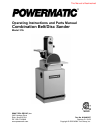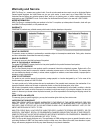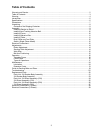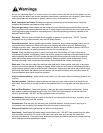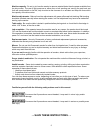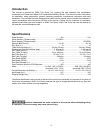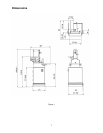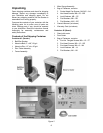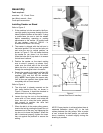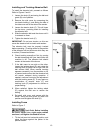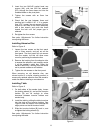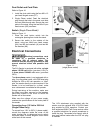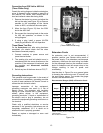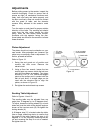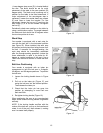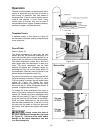
5
Machine capacity. Do not try to force the sander to remove material faster than the power available from
the drive motor. The use of light pressure on either disc or belt sanding and moving the part back and
forth will maximize belt or disc life, help to minimize the chances of an accident and keep the force within
the capacity of the drive motor.
Machine adjustments. Make all machine adjustments with power off except belt tracking. Belt tracking
should be checked manually before starting the sander, but final adjustment may have to be made after
starting up the sander.
Table safety. Be sure the table is locked in position before placing stock on it and that its front edge is
within 1/16” or less, of the disc or belt.
Job completion. If the operator leaves the machine area for any reason, the sander should be turned
"off" and the abrasive belt and disc should come to a complete stop before his/her departure. In addition,
if the operation is complete, he should clean the sander and the work area. Never clean the sander with
power "on" and never use the hands to clear sawdust and debris; use a brush.
Replacement parts. Use only Powermatic or factory authorized replacement parts and accessories;
otherwise the warranty and guarantee is null and void.
Misuse. Do not use this Powermatic sander for other than its intended use. If used for other purposes,
Powermatic disclaims any real or implied warranty and holds itself harmless for any injury or damage
which may result from that use.
If you are not thoroughly familiar with the operation of sanders, obtain advice from your supervisor,
instructor or other qualified person.
Drugs, alcohol, medication. Do not operate this machine while under the influence of drugs, alcohol, or
any medication.
Health hazards. Some dust created by power sanding, sawing, grinding, drilling and other construction
activities contains chemicals known to cause cancer, birth defects or other reproductive harm. Some
examples of these chemicals are:
* Lead from lead-based paint.
* Crystalline silica from bricks and cement and other masonry products.
* Arsenic and chromium from chemically-treated lumber.
Your risk from these exposures varies, depending on how often you do this type of work. To reduce your
exposure to these chemicals, work in a well-ventilated area, and work with approved safety equipment,
such as those dust masks that are specifically designed to filter out microscopic particles.
Familiarize yourself with the following safety notices used in this manual:
This means that if precautions are not heeded, it may result in minor injury and/or
possible machine damage.
This means that if precautions are not heeded, it may result in serious or possibly even
fatal injury.
- - SAVE THESE INSTRUCTIONS - -



